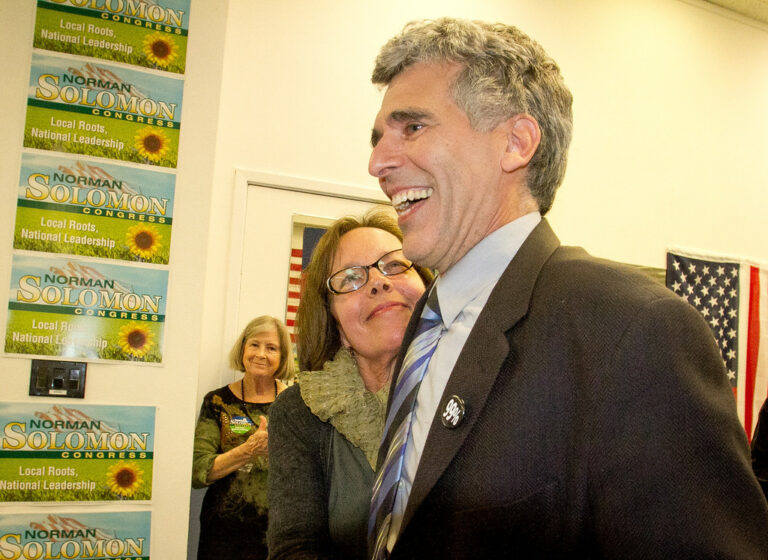This interview was originally published on August 10, 2017. On Reality Asserts Itself, Paul Jay talks to the president of the Chicago Principals and Administrators Association, Troy LaRaviere, about his new report that found systemic racial discrimination in the way Chicago Public Schools receive special education funding.
Paul Jay: Welcome to the Real News Network. I’m Paul Jay, and welcome to Reality Asserts Itself. Normally, on RAIs, I introduce our guest, and we do a personal background, more why they think what they think, and then get into some of the issues, but because there’s a news-breaking issue associated with our next guest, we’re going to first dig into the issue and then get into his story in the following segments. Troy LaRaviere is the President of the Chicago Principals and Administrators Association. He was removed and subsequently resigned from his position as principal at Blaine Elementary School after speaking out against Mayor Rahm Emanuel and his handling of the Chicago Public Schools system. For those of you that might not remember, Rahm Emanuel used to be President Obama’s chief of staff. Troy’s now exploring a run for mayor himself. Troy and the Chicago Principals and Administrators Association are releasing a report on the Emanuel policy in Chicago Public Schools. The report focuses on systemic discrimination against poor students of color with special needs. With 158 Chicago public schools submitting budget appeals, the 10 majority-white schools received 60% of what they asked for, while majority-Hispanic schools received just 14% and majority-black schools, only 9%. The report accuses the Emanuel administration of systemic racial discrimination. Now, joining me in the studio is Troy LaRaviere. Thanks very much for joining me.
Troy LaRiviere: Thanks for inviting me. Good to be here.
Paul Jay: You just released a press release that is the beginning of the release of the major report, and I’ll just read it here, is that, “The Nauseating Racial Discrimination of Rahm Emanuel’s Chicago Public Schools …” Your language in the press release, your language in the report itself, is pretty strong. First of all, what is the evidence that this is systemic racial discrimination and not just lack of resources? Let me say, part of in researching this, I guess part of the defense of the Emanuel administration and CPS, Chicago Public Schools, is that the state is not funding the city. In fact, I think they’re suing the state to try to release more money, so why isn’t this the state’s fault? Why is this Rahm Emanuel’s fault?
Troy LaRiviere: It’s both, but Emanuel is trying to push it on the state. The state is trying to push it back on Emanuel. It’s both. One of the things I like to say is that in Illinois, Springfield is where our state government is headquartered, and one of the things I like to say is that inaction in Springfield is no excuse for inaction in Chicago. Yes, the state needs to exact, but the state is not the reason for all of our budget woes. They talk about the funding formula and how unfair it is, and it is unfair, but that funding formula has been in place for decades. CPS has not always been in crisis.
Paul Jay: CPS meaning Chicago Public Schools.
Troy LaRiviere: Chicago Public Schools has not always been in crisis. The funding formula that’s in existence now was in existence when we had $1 billion of surplus. The funding formula that’s in place now was in existence when the teachers’ pension was fully paid up. If that was the same then, what changed to create this crisis situation? What changed was not the state funding, even though it is inadequate. What changed is the way CPS spends and borrows money in its extremely wasteful manner. CPS stopped paying into the pensions and started this extravagant building spree, building I think 40% more schools for a district that did not get new students. You build new schools when you get new students. They built new schools as a school reform ideology, spent hundreds of millions of dollars on this.
Paul Jay: They’re closing schools.
Troy LaRiviere: Right. It makes no sense.
Paul Jay: Who made money out of building all these schools?
Troy LaRiviere: There is actually a federal incentive. There was a big thing that came out of Democracy Now, if I remember correctly. Juan, I forgot his last name, who works for-
Paul Jay: Gonzales.
Troy LaRiviere: Juan Gonzales, who works for that, who reports for and investigates for them, found that there is a federal incentive for banks to invest in school construction. They can double their profits if they invest in school construction. They find politicians to invest in who have control over school boards and school districts, and lo and behold, when a politician like Rahm Emanuel, who gets a lot of his campaign financing from banks, gets into office, his school reform strategy becomes to build lots of new buildings. Not get kids better services, not get more staff, not get better staff, but to build new buildings and create new schools in a district that’s not getting new students. Strategies like that have created the crisis that CPS is in right now.
Paul Jay: We’ll get into this more. There’s an overall underfunding issue, but the report is specific about special needs kids, and that there’s systemic racial discrimination in how money’s being spent on special needs kids.
Troy LaRiviere: Right.
Paul Jay: What’s the evidence of that?
Troy LaRiviere: The underfunding is at the base of it, because this report is about an appeals process. If schools did not have enough, and no school had enough, it could file an appeal to get more for its special education students. Our report focuses on what happened when schools filed an appeal.
Paul Jay: The appeal is to Chicago Public Schools, which is under the auspices of the city.
Troy LaRiviere: Exactly. The appeal is to Chicago Public Schools. Our school board is appointed by our mayor and controlled by our mayor. When people filed appeals, this is what happened. 158 schools filed. Of those 158-
Paul Jay: Out of how many?
Troy LaRiviere: Out of 600. 158 out of 600, and there were reasons. 84% in a survey said their budgets were inadequate, but only about 30% or so filed an appeal, and there were reasons for that in terms of them being discouraged from doing so. For example, one principal told us that his network chief … A network chief is like a middleman with the district. He’s in charge of about 30 or 40 schools, he or she. His network chief told him that he would see filing an appeal as evidence of the fact that they don’t know how to handle their budget. They were actively discouraged from filing appeals. Some were made to feel like their evaluations as principals would be lowered if they filed an appeal. It got that bad. Despite that, 158 schools still filed appeals. Of those 158, 10 were majority-white, 60 were majority-Hispanic, 76 were majority-black, and the rest did not have a majority population, or no population over 50%.
Paul Jay: Just you told me off camera, and I’ll make sure I’ve got this right, schools in Chicago are something like about 40% Hispanic, 40% black, or 45?
Troy LaRiviere: Yeah, a little more Hispanic, about 45-40.
Paul Jay: 10-15% not black or Hispanic, and you were telling me probably 10% or less white students.
Troy LaRiviere: Right.
Paul Jay: Okay, and the white areas, generally higher income.
Troy LaRiviere: Generally, absolutely.
Paul Jay: Okay, so what did you find?
Troy LaRiviere: What we found is that when we looked at how much the schools asked for versus how much they received from CPS, majority-white schools got 60% of what they asked for, majority-Hispanic schools got 14% of what they asked for, and majority-black schools got just 9% of what they asked for. Then we looked at it another way. We looked at the 10 schools in the district that had the highest percentage of white students, and we looked at the total that was awarded to those 10 schools. What we found is, those 10 schools got $1,033,000. Those are the 10 schools that have the highest percentages of white students. Then we looked at the 10 schools that had the lowest percentage of white students. All 10 of these were majority-black schools. We wanted to do … Because there are only 10, and then there’s 76 majority-black schools, we wanted to find a way to compare them. We took the 10 schools that had the highest percentage of white students and the 10 that have got the lowest percentage. While the 10 that had the highest percentage got over $1 million, do you care to take a stab at what the 10 schools that had the lowest percentage of black students got?
Paul Jay: Zero.
Troy LaRiviere: Zero. Not a dime. When I say nauseating, it’s nauseating. It’s flagrant. It’s not like there’s just a slight difference. $1,033,000 to zero. We actually took the four majority-white schools that got the most out of this appeals process, and it was $828,000. Only $3.5 million were granted to 158 schools, $3.5 million. Four majority-white schools got $828,000 of that $3.5 million. That’s about 2% of the schools getting a quarter of the funding. We looked at these four majority-white schools, put them on one side of a scale, imagine if you will. Then we took the 76 majority-black schools and ranked them according to how much they were awarded, from those that got zero to those that got the top amounts. We began to put those schools on another side of that scale to see how many majority-black schools we would have to put on the other side of that scale in order to get to an amount that was equivalent or comparable to what just four majority-white schools got. We had to count 74 schools before we got to an amount that was equal to what just four majority-white schools got. 74 majority-black schools.
Paul Jay: Given that the city’s majority Hispanic, Latino, and black, in terms of electoral politics, you would think that would be a serious factor in your consideration as Rahm Emanuel’s administration. Why do you think this is happening? You would think this would be politically terrible for them.
Troy LaRiviere: I don’t think they thought they’d get caught. I think that even if they do get caught, this is the same man that got caught hiding a videotape of a young child of God getting murdered. This is the same man who was found to give a $100 million contract to a custodial management agency, and right after giving that contract to them, they give him a $250,000 campaign contribution. By the way, schools became filthy after they got that contract. We just had this thing out last week where they found out they diverted $55 million in money that comes from property taxes, which normally that’s supposed to go to schools, was diverted to a hotel and stadium project. It was found out that the hotel and stadium project were themselves a diversion to get the money to Navy Pier, a Chicago tourist attraction. This is money that’s supposed to go to serve blighted communities. Navy Pier is not in a blighted community. There’s one scam, one scheme, one story after another about how corrupt this administration is. I think they think it’ll just move to the next one, and then during the election they’ll be able to put another fuzzy sweater commercial … In Chicago, the fuzzy sweater is infamous. It probably is not to your audience, but give Rahm another fuzzy sweater commercial, have him say the same talking points over and over again, and people may eventually forget.
Paul Jay: We say special needs and we talk about dollars. It sounds a little abstract, though. What are examples of what this underfunding means?
Troy LaRiviere: In education, education is a service industry. It’s a business of service. You have to have skilled, qualified professionals to provide services to your students. In Chicago, I think the thing that shows this most is the ratio of certified staff to students, or students to certified staff. By certified staff, we mean anyone who requires a state certificate to practice, a teacher, a principal, an assistant principal, a tutor, a classroom assistant, a psychologist. All of these folks have to be certified by the state. The state has a ratio of students to certified staff. How many students do you have for each certified staff member? The lower that number, the better. The state average is 10.3. 10.3 students for every certified staff member. In Chicago, the number is 15.6. We are number 849 out of 850 school districts in our state in the ratio of students to certified staff. What does that mean? That means that if I’m in a school with 600 kids, in the state of Illinois, the average school with 600 kids has 58 professional educators to serve those 600 kids. That’s not top. That’s just the state average. 58 professional educators to serve 600 kids. In Chicago, that number’s 38 to serve the same 600 kids.
Paul Jay: 600 kids, 38 licensed staff.
Troy LaRiviere: 38 licensed staff to serve 600. That’s 20 fewer than average. Not 20 fewer than the top quartile, not 20 fewer than the number 100, 20 fewer than the average. That means our students attend the most understaffed schools in the state. It means our principals lead the most understaffed schools in the state. It means our teachers teach in the most understaffed schools in the state, which means our students get the fewest or the least amount of services, because that’s where your education comes from, the adults in the building. In the end, it’s all about investment. It’s about what do we think these children are worth. What are the children in Chicago worth? What kind of investment will we put in them? The fact that we are the most understaffed or virtually the most understaffed school district in the state of Illinois says a lot about what the elected officials and appointed officials who run our district think about what our kids are worth.
Paul Jay: Special disabilities includes what sorts of things, and what does this lack of money now mean for them?
Troy LaRiviere: The setup, in addition to just this particular discrimination, our report also covers some changes they made in special ed policy. One of the things they did, for example, was change the way the individualized education plans are created. There’s a set of federal laws that determine what goes into an individualized education plan for one of these students. They’ve made it much more difficult to put a particular service into an IEP. If a service gets into an IEP, they’ve made it much more difficult to fund that service. It might be in the IEP, but good luck having it funded. At a school level, what it means is this. If I have a group of students with IEPs and they need certain services, I don’t have enough to fund those services. What CPS has said is, “Look, if you don’t have enough in your special education budget, then use your general education budget.” I just said we’re already among the most understaffed school districts in the state of Illinois, and so what they’re doing is saying, “We’ve underfunded your special ed. You’re already understaffed in general ed. We want you to further understaff your general ed so that you can fund special ed.”
Paul Jay: They’ll lose a librarian, a gym teacher, or a teacher.
Troy LaRiviere: Absolutely. You lose a librarian. You lose a gym teacher. You lose an assistant principal. You lose a security guard in order to provide that student with the special education service he or she needs. However-
Paul Jay: Aren’t those mandated, the special services?
Troy LaRiviere: Yes, they are mandated, and it’s by law. However, even if you lose that teacher to get this kid his special ed service, where do special education students spend the majority of their day? Most of them spend the majority of their day in general education classes. By getting the special education service, they still lose out on the general education service because their general education program has been understaffed. They force principals how they’re going to fail their students. How are we going to understaff? Are we not going to meet their special education need, or not meet their need to be in a classroom that doesn’t have 30 kids or more in it? You can’t have both. You have to pick your poison. That’s what it’s like being a principal in Chicago Public Schools under this particular administration.
Paul Jay: Okay. We’re going to continue our discussion with Troy as we get his own story. Troy is someone who’s very publicly stood up as a principal and now as head of the principals association against Rahm Emanuel and his education policies, and as we said in the beginning, is considering running for mayor himself. We’re going to pick up Troy’s story in the next segment of Reality Asserts Itself on the Real News Network.
Never miss another story
Subscribe to theAnalysis.news – Newsletter
“Troy A. LaRaviere is an American school administrator, educator and current President of the Chicago Principals and Administrators Association. Prior to assuming his role as president, LaRaviere served as a Chicago Public Schools principal. He began his teacher career at CPS in 1997.”










